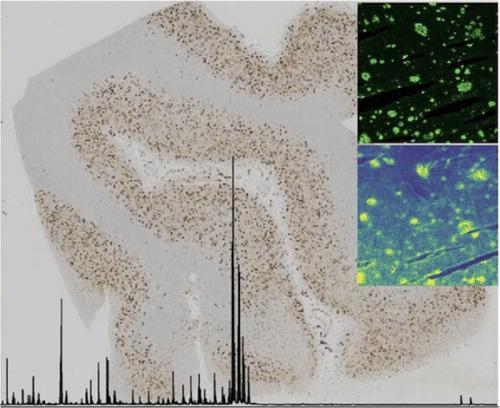当前位置:
X-MOL 学术
›
ACS Chem. Neurosci.
›
论文详情
Our official English website, www.x-mol.net, welcomes your
feedback! (Note: you will need to create a separate account there.)
Spatial Neurolipidomics at the Single Amyloid-β Plaque Level in Postmortem Human Alzheimer’s Disease Brain
ACS Chemical Neuroscience ( IF 4.1 ) Pub Date : 2024-02-01 , DOI: 10.1021/acschemneuro.4c00006
Wojciech Michno 1, 2, 3, 4 , Andrew Bowman 5 , Durga Jha 1 , Karolina Minta 1 , Junyue Ge 1 , Srinivas Koutarapu 1 , Henrik Zetterberg 1, 6, 7, 8, 9, 10 , Kaj Blennow 1, 6, 11, 12 , Tammaryn Lashley 7, 13 , Ron M A Heeren 5 , Jörg Hanrieder 1, 6, 7, 14
ACS Chemical Neuroscience ( IF 4.1 ) Pub Date : 2024-02-01 , DOI: 10.1021/acschemneuro.4c00006
Wojciech Michno 1, 2, 3, 4 , Andrew Bowman 5 , Durga Jha 1 , Karolina Minta 1 , Junyue Ge 1 , Srinivas Koutarapu 1 , Henrik Zetterberg 1, 6, 7, 8, 9, 10 , Kaj Blennow 1, 6, 11, 12 , Tammaryn Lashley 7, 13 , Ron M A Heeren 5 , Jörg Hanrieder 1, 6, 7, 14
Affiliation

|
Lipid dysregulations have been critically implicated in Alzheimer’s disease (AD) pathology. Chemical analysis of amyloid-β (Aβ) plaque pathology in transgenic AD mouse models has demonstrated alterations in the microenvironment in the direct proximity of Aβ plaque pathology. In mouse studies, differences in lipid patterns linked to structural polymorphism among Aβ pathology, such as diffuse, immature, and mature fibrillary aggregates, have also been reported. To date, no comprehensive analysis of neuronal lipid microenvironment changes in human AD tissue has been performed. Here, for the first time, we leverage matrix-assisted laser desorption/ionization mass spectrometry imaging (MALDI-MSI) through a high-speed and spatial resolution commercial time-of-light instrument, as well as a high-mass-resolution in-house-developed orbitrap system to characterize the lipid microenvironment in postmortem human brain tissue from AD patients carrying Presenilin 1 mutations (PSEN1) that lead to familial forms of AD (fAD). Interrogation of the spatially resolved MSI data on a single Aβ plaque allowed us to verify nearly 40 sphingolipid and phospholipid species from diverse subclasses being enriched and depleted, in relation to the Aβ deposits. This included monosialo-gangliosides (GM), ceramide monohexosides (HexCer), ceramide-1-phosphates (CerP), ceramide phosphoethanolamine conjugates (PE-Cer), sulfatides (ST), as well as phosphatidylinositols (PI), phosphatidylethanolamines (PE), and phosphatidic acid (PA) species (including Lyso-forms). Indeed, many of the sphingolipid species overlap with the species previously seen in transgenic AD mouse models. Interestingly, in comparison to the animal studies, we observed an increased level of localization of PE and PI species containing arachidonic acid (AA). These findings are highly relevant, demonstrating for the first time Aβ plaque pathology-related alteration in the lipid microenvironment in humans. They provide a basis for the development of potential lipid biomarkers for AD characterization and insight into human-specific molecular pathway alterations.
中文翻译:

人类阿尔茨海默病死后脑中单个淀粉样蛋白-β斑块水平的空间神经脂质组学
脂质失调与阿尔茨海默病 (AD) 病理学密切相关。对转基因 AD 小鼠模型中淀粉样蛋白-β (Aβ) 斑块病理学的化学分析表明,Aβ 斑块病理学附近的微环境发生了变化。在小鼠研究中,还报道了与 Aβ 病理学结构多态性相关的脂质模式差异,例如弥漫性、未成熟和成熟纤维聚集体。迄今为止,尚未对人类 AD 组织中神经元脂质微环境的变化进行全面分析。在这里,我们首次通过高速和空间分辨率的商用光时仪器以及高分辨率的光时间仪器利用基质辅助激光解吸/电离质谱成像(MALDI-MSI)。 - 内部开发的轨道捕获系统,用于表征携带早老素 1 突变 (PSEN1) 的 AD 患者死后人类脑组织中的脂质微环境,这些突变会导致家族性 AD (fAD)。通过询问单个 Aβ 斑块上的空间分辨 MSI 数据,我们能够验证来自不同亚类的近 40 种鞘脂和磷脂种类是否富集和耗尽,与 Aβ 沉积物相关。其中包括单唾液酸神经节苷脂 (GM)、神经酰胺单己糖苷 (HexCer)、神经酰胺-1-磷酸 (CerP)、神经酰胺磷酸乙醇胺缀合物 (PE-Cer)、脑硫脂 (ST) 以及磷脂酰肌醇 (PI)、磷脂酰乙醇胺 (PE)和磷脂酸 (PA) 种类(包括溶血形式)。事实上,许多鞘脂种类与之前在转基因 AD 小鼠模型中看到的种类重叠。 有趣的是,与动物研究相比,我们观察到含有花生四烯酸 (AA) 的 PE 和 PI 物种的定位水平有所提高。这些发现具有高度相关性,首次证明了人类脂质微环境中 Aβ 斑块病理相关的改变。它们为开发用于 AD 表征和深入了解人类特异性分子途径改变的潜在脂质生物标志物提供了基础。
更新日期:2024-02-01
中文翻译:

人类阿尔茨海默病死后脑中单个淀粉样蛋白-β斑块水平的空间神经脂质组学
脂质失调与阿尔茨海默病 (AD) 病理学密切相关。对转基因 AD 小鼠模型中淀粉样蛋白-β (Aβ) 斑块病理学的化学分析表明,Aβ 斑块病理学附近的微环境发生了变化。在小鼠研究中,还报道了与 Aβ 病理学结构多态性相关的脂质模式差异,例如弥漫性、未成熟和成熟纤维聚集体。迄今为止,尚未对人类 AD 组织中神经元脂质微环境的变化进行全面分析。在这里,我们首次通过高速和空间分辨率的商用光时仪器以及高分辨率的光时间仪器利用基质辅助激光解吸/电离质谱成像(MALDI-MSI)。 - 内部开发的轨道捕获系统,用于表征携带早老素 1 突变 (PSEN1) 的 AD 患者死后人类脑组织中的脂质微环境,这些突变会导致家族性 AD (fAD)。通过询问单个 Aβ 斑块上的空间分辨 MSI 数据,我们能够验证来自不同亚类的近 40 种鞘脂和磷脂种类是否富集和耗尽,与 Aβ 沉积物相关。其中包括单唾液酸神经节苷脂 (GM)、神经酰胺单己糖苷 (HexCer)、神经酰胺-1-磷酸 (CerP)、神经酰胺磷酸乙醇胺缀合物 (PE-Cer)、脑硫脂 (ST) 以及磷脂酰肌醇 (PI)、磷脂酰乙醇胺 (PE)和磷脂酸 (PA) 种类(包括溶血形式)。事实上,许多鞘脂种类与之前在转基因 AD 小鼠模型中看到的种类重叠。 有趣的是,与动物研究相比,我们观察到含有花生四烯酸 (AA) 的 PE 和 PI 物种的定位水平有所提高。这些发现具有高度相关性,首次证明了人类脂质微环境中 Aβ 斑块病理相关的改变。它们为开发用于 AD 表征和深入了解人类特异性分子途径改变的潜在脂质生物标志物提供了基础。































 京公网安备 11010802027423号
京公网安备 11010802027423号